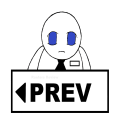When I make Video Game Returns, I start out with a planning page. I guess you could say it's also my script. I quickly scribble and doodle what I plan to draw out.
After I got everything planned out, I'm ready to begin the real page. I start off sketching everything till I get it the way I want. Then I outline the lines to make it look as perfect as possible. When I'm happy with the result, I begin the inking process.
I use a special inking set that most professional manga-ka use. I use the Manga Comic Pro inking set to ink my page as nicely as I can. Be very patient at this stage, precision is key and if you rush you could end up messing up your comic. It can always be fix on the computer later, but why add extra unnecessary work?
The thumbnails I don't give too much attention too during the pencil and ink stages. Even with a ruler I can't seem to get the lines perfectly straight o.o. I just make the thumbs using the computer, simpler and cleaner.
Okay, so here's the next and one of the most important steps. Scan your webcomic. Without a scanner, I wouldn't be able to get my comic onto the computer nor the internet. Be sure that the page is placed properly before scanning of course; last thing you need is only a portion of the page being scanned in while the rest isn't.
Once I have scanned my comic, the next step is to edit it. There are many image editing programs you can use. Some are free, while others are very pricey. I use a program called Paint.net. It's very simple to use and it's free.
The first thing I do when I begin to edit is to darken the lines. Since the scanner uses a bright ass light to scan the comic, the lines come out lite and greyish. This gets annoying, but you get used to it. Then I erase the original thumb frames and use the rectangle tool to remake them. After that's done, I start to color in the page as I see fit. When I'm thru with that, I start typing in the dialogue. I try to fit it within the thumbnail as perfectly as possible so that it's legible.
I sometimes add shading, but I don't normally do it since it's complicated and time consuming. Now here's another important step. Watermark your work!
Not many webcomikers do this, but I believe that it's necessary. All over the internet there are plenty of trolls out their lurking and won't hesitate to steal your work and claim it as their own. You can avoid this or atleast try by making a new layer and placing the comics name or your name (which ever you prefer) to overlap your comic. Then with the layer properties you reduce the visibility to around 10-15; this way the watermark is perfectly visible and won't ruin your art work. Another tactic I use is to place your webcomic sites url at the bottom of the page. This way, should someone take your comics and share them with others they'll know where to go to read more.
The last thing you want to do when editing your comic is to be sure to save the image file as a jpeg. Jpegs are perfect for web graphics. They provide good quality and load faster than PNG. PNG has better image quality but takes longer to load, and lets face it, no one wants to wait forever for a page to load. Speed is key.
The next step is a HUGE one. Making a webcomic isn't possible without making a website for it. Don't worry, you don't need to be a professional web designer for this. There are a few webcomic hosting sites out there just for this type of field. My webcomic used to be on ComicFury but all they did was whine about my comics manga format and you'd get the occasional douchbag troll. Ironicly, all my readers outside of comic fury loved the manga format. Kinda goes to show you that the pros are just smart asses sometimes. I placed VGR on Blogger due to its simplicity and organization. Organization is huge, if your comic is all over the place it'll only confuse your readers and scare them away.
Now that you have your webcomic on a good hosting platform, all that's left is to hit that publish button. All that's left is to advertise your comic to the world wide web. It can be a hassle, but the important thing is to not give up, eventually you'll get the fan base you wish for. Another tip is to have tons of strips or pages made before publishing them and release them little by little, that way if you should encounter a dilemna you wont have to worry too much about updating on time. Let your readers know how often you update so they know when to come back.
So now you know how to become a webcomic artist. I hope this rant post has helped atleast one person in some way. It doesn't matter if your artwork isn't the best, as long as your content in general is good people will come back for more. And remember, the most IMPORTANT rule of all: Have fun doing what you love. Don't let dumb troll shoot you down for they're just jealous of your work and their webcomic most likely sucks.





No comments:
Post a Comment